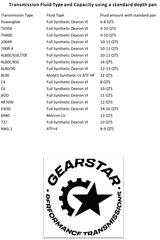Installing a Gearstar 200-4R Overdrive Transmission
Like most of you guys out there, flogging our cars at track events is only part of the equation. Hitting the open road and laying your foot down on lengthy cruises is just as gratifying — especially in homebuilt sleds. With cruising a priority, the secondhand TH350 we used in our ’72 Nova project car was a great companion, though not without its own shortcomings. The stock converter made launching the car out of the question and with only three forward gears and no overdrive, it lacked the ability to sustain modern freeway speeds without laboring. This caused road trips to be spent mostly in the slow lane at a moderate pace and also meant frequent trips to the gas station.
We needed a transmission that could do it all, and support any future engine upgrades we had in mind without worrying about reliability. Plus, the Nova had to be able to handle long cruises while producing moderate fuel economy and able to boogie down the quarter-mile.
Since the engine was removed for its own separate upgrades, it served as the perfect opportunity to scrap the tired TH350 and lame converter for an all-new transmission. Through Gearstar, we sourced a 200-4R overdrive transmission outfitted with their level III intervals and a 10-inch 2,800- to 3,600- stall converter — good for up to 500 hp and 475 lb-ft. It all came shipped complete to our door in a crate and included the Lokar installation kit. AATF transmission fluid, heavy-duty shroud, and deep transmission pan. The 200-4R offered up more response from a dig with its steeper gearing, and the overdrive (0.67:1 ratio) would accept highway cruising with significantly lower rpm. Best of all, the swap required little modification since the overall case length is nearly identical to the TH350 we pulled out, which meant we could reuse our factory driveshaft.
To get it all in, we did have to swap out the factory transmission crossmember. Lucky for us, G-Force Performance makes a complete bolt-in crossmember kit to get the job done. While removing the old drivetrain can be a small feat, it’s nothing a seasoned wrench-turner shouldn’t be able to handle. In the following pages, we’ll show you what it takes to make you transmission upgrade as easy as possible.
 |
Unlike some drivetrain removal, the Nova’s platform allows for the extraction of both the engine and transmission as one unit. Using an engine host, we picked the combo out by placing the Nova on jackstand, creating additional room for the tailshaft of the transmission to exit at a steeper angle. TO pull the drivetrain, we removed the hood—even the hood hinges. The mechanical fuel pump, battery cable, ignition wires, motor mount bolts, driveshaft, transmission mount, power steering, and radiator hoses were also all removed to free the combo from the engine bay. |
| Using the small access holes in he front subframe, we removed the bolts that attached the factory transmission crossmember. We used a 9/16-inch socket and then slid the crossmember out. |  |
 |
G-Force Performance Crossmember. When compared to the factory crossmember, the difference is obvious between the G-Force piece and the stamped unit; it saved time and any unneeded fabrication. Each crossmember is built with performance in mind and designed with large exhaust clearance humps for aftermarket systems. A durable black powdercoated finish means it’ll last the lifetime of the vehicle and all crossmembers come with new 7/16-inch hardware and correct transmission mount |
| To install the new crossmember, we first enlarged the holes in the subframe from 3/8 to 7/16 inch with a drill bit. Next, we slid in the new crossmember over the exhaust and bolted it into place using the supplied Grade 8 hardware. |  |
 |
Going the extra mile, Gearstar has thought of everything to make the 200-4R swap a cinch and even included a Lokar installation kit. The kit comes with a flexible fill tube and stick, throttle valve pressure cable, and carburetor bracket. |
| Not ready to swap out for newer transmission lines? Lucky for us, the TH350 lines are a direct fit to our new 200-4R. We secured them into their new location on the 200-4R with a 1/2-inch flare nut wrench. Using the old lines with the rubber hose (inlet/return) will allow us to at least get the car back up and running again before we bend our own custom lines at a later time. Note: Transmission fluid is highly flammable under pressure (up to 250 psi) and rubber transmission hose lines are not advised for long term use. |  |
 |
To change it up a bit, we went ahead and installed the transmission by itself. To do this, we placed the Nova on jackstands and slid in the new 200-4R from underneath the car. |
| To simplify the crossmember swap, we relied on the G-Force transmission mount; it’s a polyurethane piece and came with all-new hardware and washer plate. |  |
 |
With our fresh transmission mounted on the crossmember and supported by a hydraulic jack, all that’s left is to drop in the engine and bolt it up for final fitment. |
| The Road Test. Our first experience with the new Gearstar 200-4R transmission was at this year’s Run To The Coast event in El Toro, California. We easily racked up well over 160 miles in one day without so much as a hiccup. We cruised effortlessly at 75 mph at 2,300 rpm, and the transmission was smooth, providing us with instant downshifting whenever we got throttle happy. As soon as the converter locked up it was like another gear. While we don’t have exact mileage numbers, we can tell you cruising over 1,000-rpm less than before in the fast lane has saves us numerous trips to the gas station. We’re only kicking ourselves for not doing this sooner. If you’re still slushing around in a three-speed with no overdrive, get on track and upgrade. You won’t regret it! |  |
 |
Using new Grade 8, 7/16x 1 1/2-inch hardware, we mounted the 200-4R transmission to the back of the block and used a 9/16-inch open wrench to secure it into place. |
| Be careful to avoid any wires or lines that may be lingering between the transmission case and body of the chassis. While lining up the motor and transmission, we made that mistake and had to replace this section of wiring. |  |
 |
Once the motor is secured to the transmission, we could then fasten the torque converter to the flexplate. We applied a small amount of Loctite to the threads to help prevent them from backing out. |
| Installing the transmission shifter bracket onto the oil pan rail required using the inner elongated boltholes. Then, we ran the shifter cable through to the GM lever and attached it to the “C” hole. Note: Trimming of the bracket may be necessary to fit on cast-aluminum pans. |  |
 |
Modifying the shifter was one of our last steps to convert from our TH350 to the new four-speed, 200-4R. We simply removed the shroud from our TCI Automotive ratchet shifter and pulled the small pin out of the shifter mechanism to access all four gears through the shifter. |
| Before we took our first testdrive, we filled the transmission with Royal Purple’s high-quality Max ATF synthetic fluid. It’s specifically designed for high-performance applications like ours and protects against heat and friction. |  |
 |
Worried about lockup on the converter? Gearstar provides this vacuum switch, which is controlled by engine vacuum. It prevents lockup under full throttle and extends it in Fourth gear only at highway speeds. It also disengages lockup prior to Fourth to Third gear downshift, too. Also, it’s adjustable and can be tuned to your driving style with the supplied Allen wrench. |
 |
|


